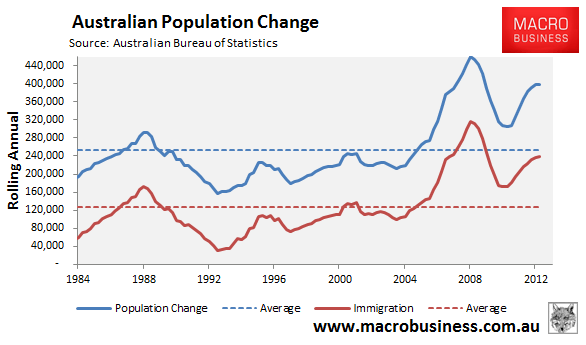
One of my key aims of commentating on policy matters is to influence debate and ultimately promote reform. The main way that I attempt to do so is via ‘advocacy’: essentially restating ideas and arguments over-and-over in the hope that enough people read them so that they become mainstream. It can be a tedious process, but is essential if one hopes to shift debate in the right direction.
Over the past two years, I have taken a particularly strong opposition to the common view that the high level of immigration into Australia – which is currently running at roughly twice the long-run average (see next chart) – is unambiguously good for the economy and in the nation’s best interests (see here for my general view).

Over the past month or so, Business Spectator’s Rob Burgess has written two articles arguing strongly for maintaining Australia’s high immigration intake, first arguing that it is an “economic no-brainer” and then returning to claim that high immigration is essential to curb the impacts of an ageing population. On both occasions, Burgess’ arguments were thoroughly debunked by me (see here and here).
To Burgess’ great credit, he has taken note of my responses and over the weekend posted an article entitled: “How I got it wrong on population”, which acknowledged how the economic arguments around high immigration are not an “economic no-brainer” after all:
Can we ‘afford’ continued high migration?
Economist Leith van Onselen sent me an intriguing article last week in which he argues that migration won’t help with the ageing population problem.
By studying dependency ratios, van Onselen finds that the ageing of the migrants themselves (assuming fairly constant fertility rates) means continuing high migration wouldn’t help things much.
He quotes the Productivity Commission which stated recently: “… an increase in annual net migration from 150 000 to 300 000 would lower the proportion of those aged 65 or over by less than 3 percentage points by 2044-45. As an illustration of the challenge, the Commission showed that delaying an increase in the dependency ratio by 40 years would require a net migration-to-population ratio of 3 per cent per year, leading to a population of around 85 million by 2044-45.”
Dr Bob Birrell, a Monash University demographer well known for his work with the Commonwealth government’s National Population Council from 1987–1993 and as a member of the independent Review of the General Skilled Migration Program which reported in May 2006, broadly backs this view…
Migrant fertility rates are not, says Birrell, significantly different to the established Aussies’ propensity to breed. And so we can’t expect them to produce an army of workers to provide for those frail boomers in 20 years’ time.
Moreover, with 90 per cent of migrants settling in our major metro areas, Birrell’s main concern is the housing and infrastructure demands they place upon public and private investment resources.
In essence Birrell sees the high migration rates of the past decade as being due to both Coalition and Labor governments worrying that there would not be enough labour to feed the mining boom. Beyond that, he doesn’t see it as having much effect on the ageing population…
Birrell points out that the “can we afford it?” question relates to the social and economic costs of pouring more people into the metro areas…
Many journalists – this one included – have assumed migration will sort out the ageing population problem.
On that, we have been wrong.
However, while Burgess’ view on immigration as an economic cure for the ageing population has changed, he still maintains that Australia’s high immigration level should continue:
However, in order to become a true middle-power; in order to not appear virtually deserted by our populous neighbours to the north; and in order to play a moral role in settling the displaced people of our region, the migration that built Australia should continue.
That position is occasionally attacked as a cynical ploy by vested interests to boost house prices and deliver strong profits to the giant finance industry that milks that sector of the economy. Well, yes, high migration does have that effect.
But there are other forces at work; other reasons to keep migration levels high. And if we fail to ‘afford’ it, it’s a failure of public policy, not because Australia’s full.
Obviously, I disagree with these views. Maintaining an immigration program around half the current level – i.e. similar to what existed before the ramp-up in the mid-2000s (see above chart) – would not meaningfully endanger Australia’s security, which can be assured via diplomacy and alliances, rather than simply importing people. And in the worst case scenario, wars are won primarily through technology rather than man power anyway. We have no hope of keeping up with the regional giants.
Further, Australia’s humanitarian intake is only a small share of Australia’s total immigration intake, so the argument that it would necessarily be endangered via a lower immigration program is bunkum. It could easily be met (or even expanded) if the total immigration intake were reduced back to longer-run average levels. Even the Stable Population Party doesn’t advocate reducing Australia’s humanitarian intake, despite arguing for much lower immigration overall.

